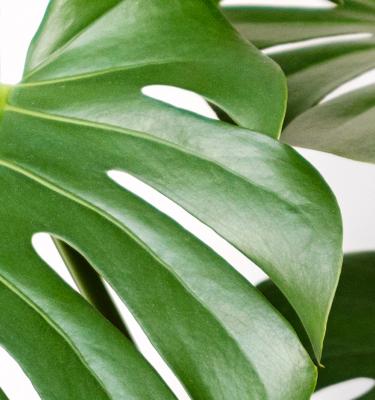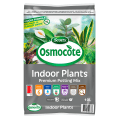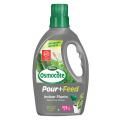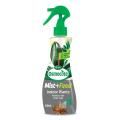

How To Grow and Care for Monstera
Monstera deliciosa is also commonly called the Swiss cheese Plant, Fruit Salad Plant or Monstera. Its large green glossy leaves become full of holes as they mature and it can be a monster grower in the right conditions.
Monstera prefers a bright spot indoors, with indirect or morning sun only. Although it will also grow outdoors in a shaded and protected, frost free spot. These plants are natural climbers, so provide them with a coir or moss covered totem pole for support.
Top 5 steps to growing Monstera
- Monstera plants prefer a spot with medium to bright indirect light - direct afternoon sun can burn their leaves.
- Use a premium, like Scotts Osmocote Premium Potting Mix to give your plant the best start possible
- Monstera like moist, but free-draining soil. Make sure the pot has drainage holes and don’t allow water to collect in saucers or the base of cover pots.
- Fertilise Monstera with an indoor plant fertiliser like Scotts Osmocote Pour+Feed for Indoor Plants once a month during spring and summer, to encourage strong healthy growth.
- Provide your Monstera Plant with a support or totem pole so it can climb and stay upright
What You'll Need for Growing Monstera
To successfully grow Monstera, you will need:
If growing in a pot
- A suitable pot
- Scotts Osmocote Premium Potting Mix
- Scotts Osmocote Controlled Release Fertiliser for Indoor Plants or Scotts Osmocote Pour+Feed for Indoor Plants or Scotts Osmocote Mist+Feed for Indoor Plants
- Moss pole
Monstera are vining plants so they will need support to climb upwards. A moss pole is ideal for this and provides a place where the aerial roots can take hold.
If growing in the ground
- Scotts Osmocote Compost Premium Soil Improver
- Scotts Osmocote Controlled Release Fertiliser: All Purpose
- A potting mix scoop or garden trowel
- Defender Pyrethrum Insect Spray
How to Grow Monstera in a pot
Choose a pot for your Monstera that’s roughly 2 times the size of the original nursery pot - make sure it has drainage holes or use a black plastic pot that sits snuggly inside a cover-pot or cache pot (pot with no holes).
Half fill your pot with Scotts Osmocote Premium Potting Mix and gently remove the Monstera from the nursery pot and position it into the potting mix, backfill around root ball with more potting mix so that the potting mix is level with, or slightly below, the top of the pot.
Water your new Monstera in well and tip out any excess water from the base of the cover-pot or saucer (if using). Fruit Salad Plants can tolerate drying out between waterings during winter, make sure the top 2-5cm of soil is dry before watering again. Although Fruit Salad Plants like a moist potting mix they don’t like wet feet, so don’t let water pool in the base of cover-pots or in saucers as they’ll quickly rot if their potting mix remains soggy or waterlogged.
How to grow Monstera in the garden
Monstera can be grown outside in a warm, frost free spot. Choose a shady spot or dappled morning sunlight with rich, moist but free-draining soil. Remember Fruit Salad Plants like to climb, so position it near a sturdy support or fence that it can climb up. If planted at the base of a tree it may climb the tree!
Dig the hole twice as wide as the original nursery pot and the same depth. Mix some Scotts Osmocote Compost Premium Soil Improver through the soil at the bottom of the whole.
Remove your Monstera from its pot and position it into the middle of the hole, backfill around the root ball with soil and water your new plant in well.
Mulch around your in ground Monstera to retain moisture and suppress weeds. They’ll need regular watering particularly during warmer or dry weather.
Fertilising & Care
Fertilise Monstera fortnightly in spring and summer with an indoor plant fertiliser to encourage new growth. Use Scotts Osmocote Pour+Feed for Indoor Plants - this is a simple to use ‘measure and pour’ feed which contains the right balance of nutrients. If you’d prefer a longer term fertilising product, with less applications, apply Scotts Osmocote Controlled Release Fertiliser for Indoor Plants in early spring and again in early autumn - this product feeds for up to 6 months.
Fertilise in ground planted Monstera with Scotts Osmocote Controlled Release Fertiliser: All Purpose in spring and early autumn.
In the warmer months of spring and summer Monstera will appreciate a more regular watering and a higher humidity. To increase the humidity around Monstera, group them with other plants to create a microclimate or mist them with a spray bottle regularly. You can also sit their pot on a saucer filled with pebbles and water - as the water evaporates it will humidify the air.
Remove any dead or damaged leaves at the base of the stem to promote new growth. If the tips of your Monstera leaves go brown it could be too much sun or too much water - try moving it to a spot with less direct sunlight (or a space with morning sunlight only) or allow the potting mix to dry out before watering again.
Because the Monstera leaves are so large, they need to be cleaned of dust regularly - use a damp, soft cloth to gently wipe each leaf to remove dust.
Pests & Diseases
Look out for distorted new growth and obvious signs of pests on the undersides of leaves. Mites, scale and mealybugs can from time to time become a problem on Monstera - use Defender Pyrethrum Insect Spray to control them if needed.
Common Questions and Answers
A healthy and happy Monstera is quite resilient to most pests and diseases, however, it’s still important to keep an eye on it!
Why is there webbing underneath the leaves of my Monstera?
This is a tell-tale sign of spider mite. So is yellowing around the leaf edges and small spots on the foliage. These pesky little critters weaken the plant by sucking goodness from the leaves. Simply, hose the leaves down outside to reduce the spider mite population and use a natural insecticide to clean up the rest.
Why are the leaves on my Monstera discoloured and mottled?
Thrips may be to blame. Look out for black-brown marks on the underside of the leaves (this is excretment). The top of the leaves may also appear silvery, yellow or brown. Remove heavily infested leaves from the plant and then treat with Defender Pyrethrum Insect Spray.
What are the brown lumps on the underside of the Monstera leaf?
This could be a scale insect. Large infestations of scale can cause white or yellow spots to appear on the foliage. Leaves may also turn yellow and possibly drop off. If they are a problem then simply use soapy water and a brush to remove them or treat scale with Defender Pyrethrum Insect Spray.
Why doesn’t my Monstera have holes in the leaves?
The problem is most likely due to a lack of light. Don’t put it in direct sunlight, but do make sure that the space is bright enough.
Are Monstera toxic?
Monstera plants are poisonous if eaten, so ensure that the plant isn’t in reach of children and pets. The fruits of the Monstera deliciosa however are edible!
Are there different types of Monstera?
With over 45 species available, there is a Monstera plant out there that will suit any aesthetic and really bring your indoor jungle to life. We’ve rounded up our top 5 favourite Monstera varieties, each with striking differences and quirky qualities – why not mix and match?!
Monstera deliciosa
Monstera deliciosa can grow long and leggy up to 5m or full and hearty if you prune regularly. Also, the holes of the common Monstera leaves create attractive indentations, especially when they reach the edge of the leaf. Monstera deliciosa is easily confused with Philodendron bipinnatifidum and both are often labelled as ‘split-leafed philodendron’, even by reputable retailers. The 2 key things that tell them apart is that Monstera deliciosa is a climbing plant and it produces fruit, whereas the Philodendron does not.
Monstera deliciosa ‘Variegata'.
Unlike the common Monstera deliciosa, this variety grows leaves that are distinctively dark green with striking white marbled patches.
Monstera deliciosa ‘Tauerii’
This plant is a dwarf version of Monstera deliciosa, with decorative heart shaped leaves and perforated foliage. It’s the perfect choice for adding a bit of greenery to your home office or living space and won’t take up as much space as the original Swiss Cheese plant.
Monstera adansonii
Monstera adansonii is petite compared to most Monsteras and only grows to about 1m in height. The holes on this plant are positioned more towards the middle of the leaf and the margins of the leaves are closed earning it the nickname ‘monkey mask’ as the slits resemble a cheek monkey peering through!
Monstera siltepecana
This variety is distinguished by its beautiful venation and silvery sheen, with strongly contrasting colourings between the leaf veins and lamina (the areas between the leaf veins). The veins are dark green and the lamina is a beautiful blue-silver colour.



